> DRY
DRUNK
THE CULTURE OF SMOKE: HIGH LIFE
Sir Walter Raleigh is credited with championing the habit of tobacco smoking
at the Elizabethan court. While it was far from being a respectable practice
throughout the general population, by all accounts the extravagantly dandified
beau monde of the late 16th and early 17th centuries immersed itself deeply
in the novelty of tobacco at a time when it was still a fresh and new, albeit
alien and savage, drink. Images and reports make clear that in Dutch, French,
and English society, the greatest propensity to smoke in the early decades
was on the part of those most eager to be at the height of fashion. Among
the early smokers were mercenary soldiers. With money to burn and a precarious,
nomadic existence, they easily fit the rugged, manly, and dandyish stereotypes
associated with tobacco.
In spite of the harsh words of James I a century earlier, the upper classes
of 18th-century England indulged themselves heartily in tobacco, reveling
in the thick, luscious clouds of smoke. The gentleman's club was the locus
par excellence for manly conversation and relaxation, aided by consumption
of a good glass of beer or punch and a fine, long, slow-burning pipeful of
tobacco. This gentlemanly practice was also on the receiving end of much
languid smoky satire, making it that much more memorable.
The 18th-century smoking club epitomizes the arguments both for and against
the devilish herb. In this milieu, its narcotic effects are plainly, blatantly
sought and achieved. Caricature in 18th-century England, from Hogarth to
Gillray, cultivated an extraordinarily keen sense of getting to the bottom
of social habits and institutions. In this world, the identity of the characters
shown smoking is no longer irrelevant, but a vital part of the equation.
56
Richard Livesay (British, d. ca. 1823) after William Hogarth (British,
1697–1764)
Mr. Ben Read. A Member of Hogarths Club at the Bedford Arms Tavern.
Drawn by Him About the Year 1757
Etching and aquatint, 1781
Print Collection, Bequest of Samuel J. Tilden
The sleepy Mr. Read's profession and his relation to Hogarth (if any)
are not known, but the print is evocative of the relaxed atmosphere in
London clubs, the function of which was to provide a sort of home away
from home. The British club (mostly male-dominated) is essentially an 18th-century
phenomenon, arising in the decades after the introduction of tea, coffee,
and chocolate. The oldest club, White's, began in 1693 as White's Chocolate
House, while the club proper was instituted only later.
57
William Dickinson (British, 1746–1823) after Henry William
Bunbury (British, 1750–1811)
A Smoking Club
Stipple engraving, published by S. W. Fores, March 15, 1794
Print Collection, Cadwalader Fund
 According to an early 19th-century writer, "The object of clubs is
asserted to be, the promotion of trade, human conversation, and the communication
of curious and scientific matter; but, according to an old writer, . .
. 'most considerate men, . . . have found, by experience, that the general
end thereof is a promiscuous encouragement of vice, faction, and folly.
. . .'"
According to an early 19th-century writer, "The object of clubs is
asserted to be, the promotion of trade, human conversation, and the communication
of curious and scientific matter; but, according to an old writer, . .
. 'most considerate men, . . . have found, by experience, that the general
end thereof is a promiscuous encouragement of vice, faction, and folly.
. . .'"
58
James Gillray (British, 1757–1815)
A Smoking Club
Hand-colored etching, published by Hannah Humphrey, February 13, 1793
Print Collection, Bequest of Samuel J. Tilden
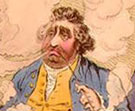 Gillray's "club," published
12 days after France declared war on England, is distinctly politicized:
the space is identified as the House of Commons by the gallery in the background,
with the Speaker at the head of the table. William Pitt (the diminutive
prime minister, who had a reputation for abstinence despite his weakness
for port), to his right, sends a cloud of smoke toward his opponent, Charles
Fox (the ever-controversial foreign secretary and Pitt's bitter opponent),
who returns the favor. The tray of pipes and tobacco paper on the table
in front of Fox refer to his reputation as a notorious man of excess. The
frothing tankard held by the scrawny Pitt, and the bowl of punch being
consumed by the Scot Dundas at the far end of the table, are, along with
the pipes and tobacco, a mainstay of the club scene.
Gillray's "club," published
12 days after France declared war on England, is distinctly politicized:
the space is identified as the House of Commons by the gallery in the background,
with the Speaker at the head of the table. William Pitt (the diminutive
prime minister, who had a reputation for abstinence despite his weakness
for port), to his right, sends a cloud of smoke toward his opponent, Charles
Fox (the ever-controversial foreign secretary and Pitt's bitter opponent),
who returns the favor. The tray of pipes and tobacco paper on the table
in front of Fox refer to his reputation as a notorious man of excess. The
frothing tankard held by the scrawny Pitt, and the bowl of punch being
consumed by the Scot Dundas at the far end of the table, are, along with
the pipes and tobacco, a mainstay of the club scene.
59
William Hogarth (British, 1697–1764)
A Midnight Modern Conversation
Etching and engraving in red ink, 1732/3
Print Collection, Bequest of Samuel J. Tilden
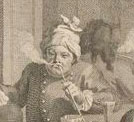 Hogarth, who is credited with establishing Britain's reputation in
the visual arts, was a clever satirist as well as a competent businessman
whose prints assured his fame. The popularity of this print is evident
in the proliferation of copies on paper, punch bowls, and cups; it also
inspired a popular play. Said to depict St. John's Coffee-house, Temple
Bar, it exhibits varying stages of drunkenness, with brimming punch bowl
and tobacco smoking equally important components. Hogarth denied that any
of the characters were intended as portraits, but contemporaries inevitably
found striking likenesses, including that of the tobacconist, John Harrison,
wildly gesticulating in the back, and placing a second wig on the parson's
head.
Hogarth, who is credited with establishing Britain's reputation in
the visual arts, was a clever satirist as well as a competent businessman
whose prints assured his fame. The popularity of this print is evident
in the proliferation of copies on paper, punch bowls, and cups; it also
inspired a popular play. Said to depict St. John's Coffee-house, Temple
Bar, it exhibits varying stages of drunkenness, with brimming punch bowl
and tobacco smoking equally important components. Hogarth denied that any
of the characters were intended as portraits, but contemporaries inevitably
found striking likenesses, including that of the tobacconist, John Harrison,
wildly gesticulating in the back, and placing a second wig on the parson's
head.
60
Edmund Scott (British, ca. 1746–1810) after John Boyne (British,
1750–1810)
The Smoaking Club
Etching published by Bull and Jeffryes, January 10, 1792
Arents Tobacco Collection
On the subject of a smoking club, the Rev. George Crabbe (1754–1832)
penned the following:
A Club there is of Smokers –Dare you come
To that close crowded, hot, narcotic Room?
When midnight past, the very Candles seem
Dying for Air, and give a ghastly Gleam;
When curling Fumes in lazy Wreaths arise, . . .
When but a few are left the House to tire,
And they half sleeping by the sleepy Fire;
Ev'n the poor ventilating Vane that flew
Of late, so fast, is now grown drowsy too . . .
Clubs and Social Meetings (1810)
61
G. P. Harding (British, active 1st half 19th century) after William
Hogarth (British, 1697–1764)
Portrait of William Hogarth Holding His Pipe [after self-portrait in
coll. of the Duke of Bedford, 1761]
Stipple engraving, 1825
Print Collection, Bequest of Samuel J. Tilden
62
Unidentified (British, last quarter 18th century)
Enjoying a Friend
Etching, published by Laurie & Whittle, August 21, 1798
Arents Tobacco Collection
63a-d
Jan van de Velde (Dutch, 1593–1641)
Market scene including an outdoor tobacco shop
Four etchings, 1620s
Print Collection, Kennedy Fund
In the midst of this crowded Dutch market scene, replete with vegetable
vendors and quacks, peasants and the fashionable upper classes, young and
old, an outdoor tobacco shop is set up on a barrel, and a young dandy tries
what could be his first puff of tobacco smoke through a pipe provided by
the salesman, who quietly smokes his own pipe. Children, very much present
throughout van de Velde's market scenes, are extra-attentive to both the
smoker and the quack, who present both the greatest novelty, and the most
dubious activities.
64a-c
Wenceslaus Hollar (Bohemian, 1607–1677)
Smoking scenes
Three etchings, 1635
Arents Tobacco Collection
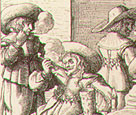
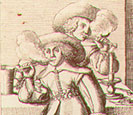
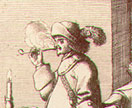 In 1635, when these prints were made, Hollar was living in Cologne
and had, in the previous year, made a trip to the nearby Netherlands, where
he was as much intrigued by the art he saw as with the landscape and people.
Close links to Dutch genre painting are evident in these diminutive scenes,
and it is surely not coincidental that the only reference to tobacco in
all of Hollar's nearly 3,000 prints dates to his first visit to Holland,
where tobacco was an important commodity and smoking still a relatively
new fashion.
In 1635, when these prints were made, Hollar was living in Cologne
and had, in the previous year, made a trip to the nearby Netherlands, where
he was as much intrigued by the art he saw as with the landscape and people.
Close links to Dutch genre painting are evident in these diminutive scenes,
and it is surely not coincidental that the only reference to tobacco in
all of Hollar's nearly 3,000 prints dates to his first visit to Holland,
where tobacco was an important commodity and smoking still a relatively
new fashion.
65
Abraham de Bosse (French, 1602–1676) after Jean de St. Igny
(French, d. 1647)
Les Fumeurs [The smokers]
Etching, ca. 1635
Print Collection, Gift of an Anonymous Donor
The rather dandified soldiers pictured here are enjoying a relaxing
smoke; the playing cards off to the side and the glass suggest their other
activities. A verse that has been trimmed from this impression suggests
that tobacco both revives the men from melancholy and prepares them for
future fighting. A copy of the print was used on a 1641 English Puritan
broadside attacking Charles I, in which the verses speak to the temperance
inherent in dining on "a leafe," a reprise of the Amerindian theme of tobacco
as sustenance, while the text of the broadside centers on the theme of
the prodigal son.





